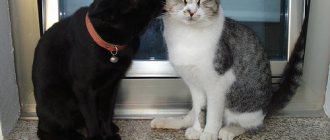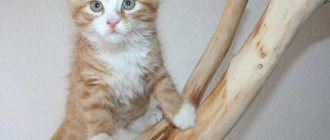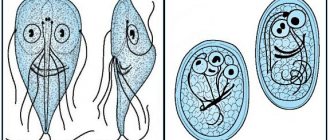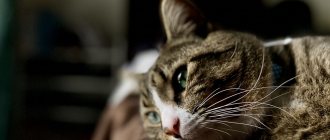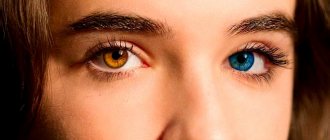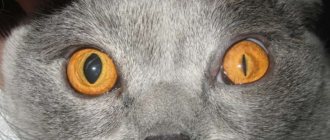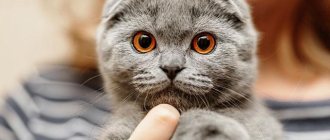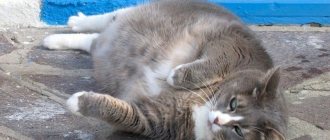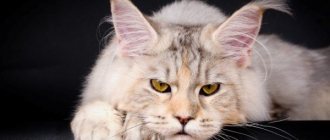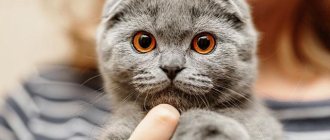In cats, the pupil is located in the central part of the iris. The pupil is necessary for the correct passage of the light beam to the retinal area. In accordance with the amount of light, the pupil is able to expand or contract.
It is noteworthy that both pupils simultaneously dilate in a dark room with a lack of light and contract in bright light.
In cats, a pathology such as anisocoria may occur, characterized by a change in one pupil in relation to the other. One pupil is larger than the other. In rare cases, pathological constriction of the pupil is observed. As a rule, with anisocoria, the pathological pupil is dilated.
Features of cat vision
All representatives of the cat family are characterized by the so-called bipolar vision, due to which both eyes intersect in the same direction, fixating on a certain point. Such structural features of the visual apparatus are due to nature itself. Such an unusual arrangement of the eyes allows the cat, which is a predatory animal by nature, to determine the distance to a particular object as accurately as possible, which is extremely important and valuable during the hunt.
The structure of cat pupils is also unique. They initially have a narrow vertical shape, which can change depending on the environment and the influence of external factors. When there is too much lighting, the pupil of furry pets automatically begins to constrict. At the same time, the amount of absorbed ultraviolet rays decreases. This anatomical feature performs an important protective function, helping the animal to avoid blinding in excessively bright, intense light.
Scientists have found that it is the narrow shape of the pupil that allows cats to independently regulate the process of absorbed light with the participation of the lower and upper eyelids. The visual organs of pets are characterized by increased sensitivity and susceptibility to light. This is the main difference between cat eyes and human or other animals.
A vertical, narrow pupil, the ability for bipolar vision - allow representatives of the cat family to automatically adjust the level of light exposure, greatly reducing the risks of traumatic, burn injuries, visual impairment, and even the onset of absolute blindness.
Cat vision
We have studied a lot of available materials and collected only objective and indisputable facts that will allow us to better understand cats, and, if desired, to feel the world through the prism of their perception. This article is about cat vision. For humans, vision is perhaps the most basic sense. How are things going with cats?
Of course, vision is also very important for cats; it allows them to perceive the outside world, gives them an idea of the surrounding objects, their size, shape, and movement. However, unlike you and me, cats have significantly developed senses that help them navigate in space. They have whiskers (vibrissae), the most important organ of touch, which makes it possible to navigate at close range. And over long distances they are helped by their sense of smell, which is developed in them, although somewhat less well developed than in dogs, but much better than in humans. For example, to find water, a person must see it, but a cat can find it by smell.
When vision deteriorates, the cat compensates for this so successfully with other senses that owners may not immediately pay attention to it and will notice it only when the problem has become serious. That is why it is important for us to understand the visual characteristics of cats, to know the symptoms of disorders of this function and, of course, recommendations for eye care.
SIGNS OF BLINDNESS IN CATS
- The cat refuses to jump or does it awkwardly.
- The cat stumbles upon objects that are in a new place for it.
- The cat looks past you.
- The cat's pupils are statically dilated.
If your cat has lost her sight, remember that she should not be allowed out of the house, and it is not advisable to rearrange the furniture, as well as food and water bowls.
When a cat knows where something is, it can navigate perfectly even blindly, using its other senses. Cats' vision is in many ways similar to human vision, but there are a number of differences. Let's look at the main characteristics of cats' vision.
Cats have 3D vision
Cats' eyes are located close to each other and directed forward. The sectors that the cat perceives with its right and left eyes overlap, which allows it to see the same object with both eyes at the same time. Thanks to this, cats are able to determine the shape, size of an object and the distance to it. The angle of binocular vision in cats is 140 degrees.
A cat also has a fairly large viewing angle - 200 degrees (for humans - 180 degrees). 3D vision helps a cat accurately assess the location of an object, which is especially important when hunting. But the rodents that cats hunt have eyes on both sides of their heads, and they see two separate pictures.
Cats see better in the horizontal plane
Preparing to jump, the cat shakes its head up and down in order to, by changing the angle of view, determine the distance to the object as accurately as possible. It has been proven that a cat reacts more actively to the movement of objects in the horizontal plane than to vertical movement, because mice move precisely in the horizontal plane. Cat owners should take this into account when inviting their cat to play.
Cats have trouble seeing up close
Cats cannot clearly focus their gaze on nearby objects. The minimum distance at which a cat can see well is about 50 cm. If you put an object directly under the cat’s nose, then she will explore it by touching it with her whiskers (vibrissae), and not with the help of her eyesight. That is why owners, when playing with a cat, need to keep the toy at a sufficient distance.
Cats see the world primarily in shades of gray
A cat's eyes are designed in the same way as a person's. Light passes through the cornea, the anterior chamber of the eye, the pupil, the lens, the vitreous body and hits the retina (the inner light-sensitive membrane).
Photoreceptors (special nerve cells) on the retina of a cat's eye convert the light falling on them into nerve signals, which are then transmitted to the brain.
Photoreceptors vary in shape and are divided into two types: rods and cones.
The rods contain only one type of pigment; they provide twilight, colorless vision.
Cones contain two types of pigment, and they form the basis of cats' two-tone daytime color vision. (In humans, there are three types of pigment in cones, and therefore three-color vision).
In a cat, like a twilight animal, rods predominate on the retina of the eye, and only in the central part are cones concentrated; This is the area of acute vision. The ratio of rods to cones in cats is 25:1, and in humans it is 4:1.
A cat can distinguish shades of color much worse than a human. They see clearly only in the blue and green-yellow parts of the spectrum. But at the same time, cats are able to distinguish a large number of shades of gray. This feature of vision can be explained by the color of the main victims of cats - mice, the color of which varies from light gray to brownish-gray. Therefore, when buying a bright toy, you are doing it for yourself, and not for the cat. Opt for gray tones.
Cats prefer twilight
The statement that a cat sees perfectly in the dark is not entirely true. In absolute darkness, a cat cannot see. But in order to see well, a very small amount of light is enough for her - ten times less than for a person.
Cats' vision is tuned to perceive dimly lit spaces, which is especially important for hunting, since small rodents lead a twilight and nocturnal lifestyle. And in good lighting, a cat distinguishes details worse than a human, preferring darkened rooms.
Excellent vision in the twilight of cats is provided by a special formation - tapetum, which humans do not have. Light, passing through the rods and cones, is reflected from the tapetum, returns and again irritates the nerve endings. Thus, the rods and cones in the cat’s eye are irritated twice, which helps improve visibility at dusk and explains the cats’ dislike of bright light. It's also interesting that the tapetum causes a cat's eyes to glow in the dark as light reflects off its greenish-yellow surface.
A cat's pupil may narrow to a narrow slit.
In bright light, cats' pupils constrict to a narrow vertical slit—a very effective way to reduce light output.
Cats watch every move
Cats recognize a moving object better than a stationary one. They can see a moving object at a distance of 800-900 m. On the retina, a moving object sequentially activates groups of photoreceptors, then the information goes to the brain, where specific cells (moving edge detectors) make cats react to the presence of prey or an enemy.
That is why, during a hunt, a cat can simultaneously guard several mouse holes, instantly reacting to the subtle movement of rodents.
Cats have a third eyelid
The third eyelid can be seen in the inner corner of the eye. It can be light pink or pigmented. The third eyelid helps tear fluid move through the eye and further protects the eye.
EYE DISEASES
Healthy cat eyes are clean, wide open and do not require special care - you just need to examine them periodically and wipe them with a damp cloth as necessary. Also, your cat’s eyes need to be washed if you notice slight red-brown crusts in the inner corner of the eye or slight tear stains. However, since eye diseases are, alas, not uncommon for cats, if suspicious changes appear in the eye area, it should be shown to a veterinarian.
It is important to note that diseases that affect the eyes of cats can be not only ocular, but also systemic. A number of infectious diseases occur with purulent discharge from the eyes, for example, feline herpesvirus type 1 (infectious rhinotracheitis) and chlamydia.
Therefore, it is so important to start treatment on time. This will save your pet not only his eyes, but also his life.
BE ALERT IF ANY DEVIATIONS APPEAR:
| in cat behavior: | in eye condition: |
|
|
Since the number of diseases is very large, of course, there is no universal cure. You should not hope that the disease will go away on its own. You can't spread the disease!
You cannot self-medicate! Be sure to show your cat to a veterinarian!
The only thing you can do yourself before visiting a specialist is to wash your cat’s eyes with water or any eye wash solution, for example, furacillin solution or chamomile decoction. You can also apply 1% tetracycline eye ointment to the lower eyelid. Throughout the course of the disease, the cat needs special daily care - it is necessary to clean and rinse its eyes before using medications.
When the doctor makes a diagnosis and prescribes treatment, the cat owner should follow simple rules to achieve optimal results and a speedy recovery for the pet.
- First, strictly follow all doctor’s instructions,
- secondly, observe the cat, carefully monitor changes in its condition and in case of any deviations, be sure to consult a doctor.
- Third, use an Elizabethan collar to prevent the cat from rubbing its already sore eyes. Only remove it when your cat is feeding.
THE MOST COMMON EYE DISEASES IN CATS
Conjunctivitis is an inflammation of the mucous membrane of the eyes. Keratitis is inflammation of the cornea. Entropion of the eyelids (more common in Persian, British, Scottish cats, Maine Coons). Sequestration (necrosis) of the cornea. Epiphora - profuse lacrimation. Retinal detachment (usually associated with hypertension)
HOW TO WASH A CAT'S EYES?
- It is necessary to prepare an eye wash solution, sterile gauze pads or clean cotton pads in advance. Remember that the solution must be at room temperature. Do not use the solution straight from the refrigerator!
- Remember to wash your hands thoroughly.
- It is very important to securely restrain the cat so that it does not injure you or itself. It is advisable not to carry out the procedure alone; use the help of other family members.
- If crusts have formed around the eyes, generously moisten a napkin with the solution and soak the crusts for 1-2 minutes. Then carefully remove the soaked formations from the wool.
- You can wash your eyes with a cloth soaked in the solution, using a syringe with the needle removed, or a syringe. Gently part your eyelids and apply the solution to the upper outer corner of your eye.
- Wipe the eye area, eyelids and fur with a dry cloth from the outer to the inner corner of the eye.
Source: My friend the cat 2012-09
Additional functions
Initially, the cat is a wild predatory animal, leading a predominantly nocturnal lifestyle. In its natural habitat, it is at dusk that the cat goes hunting and searching for prey for food. It follows from this that the visual apparatus of animals is designed for night mode, therefore their eyes are hypersensitive, allowing them to see perfectly in the dark and even in complete darkness.
For this reason, the size of a cat's pupils can change noticeably throughout the day. After carefully observing your pet, you can see that in the bright sun or under intense artificial lighting, its pupils narrow greatly and become like small slits, but when darkness sets in, on the contrary, they acquire a rounded shape and increase in size.
This process is considered absolutely normal and indicates that the animal is in good health, and its visual apparatus is functioning correctly, performing important protective functions.
Treatment of anisocoria in animals at the RosVet Exhibition Center
All therapeutic appointments are made after the true cause of anisocoria has been identified. Based on the preliminary diagnosis, a veterinary ophthalmologist can refer the pet for additional examination to specialized doctors, for example: a neurologist, surgeon or oncologist.
It is important to know! There can be many reasons for anisocoria, so the owner must be prepared for a long examination and subsequent treatment of the underlying disease. You can’t leave it like this – it’s fraught with the development of irreversible consequences!
If you notice that your dog or cat has different sized pupils, don’t hesitate! Call the RosVet VC by phone. The clinic administrator accepts applications around the clock. Remember that anisocoria can be a sign of severe internal lesions that need to be addressed immediately.
Possible causes of constricted pupils in a cat
Quite often, the pupils of cats become very narrow even in moderate lighting or in twilight. According to veterinarians, this can be caused by:
- painful sensations;
- estrus period (read more about the cat’s first estrus);
- a sharp release of adrenaline into the blood (possible during stressful situations, moving, visiting a veterinary clinic, hunting, and even during active, outdoor games);
- anger, aggression, desire for revenge.
In most cases, excessive constriction of the pupil in a cat is not a cause for concern, as it is explained by natural processes occurring in the animal’s body.
Anisocoria: symptoms and diagnosis
Externally, the owner of a cat or dog can independently notice anisocoria; it is enough to look into the eyes of the animal in the same lighting (bright light). Normally, in the light, the pupil narrows evenly in both eyes; with anisocoria, a discrepancy is clearly visible - in the affected eye the pupil is dilated.
At the RosVet VC, ultrasound examinations are used to assess the condition of the damaged eye and retrobulbar area. A more accurate assessment can be given by MRI and CT, with their help it is possible to identify a lesion in the central nervous system and accurately localize the location of the lesion.
If CNS disease is suspected, a spinal puncture is performed, and electroretinography is performed to determine the functioning of the optic nerve.
To help the ophthalmologist make a diagnosis and differentiate the most likely eye pathologies, the following drugs are used:
- phenylephrine;
- physostigmine;
- pilocarpine.
Pharmacological tests provoke denervation hypersensitivity when damaged at the postganglionic level. A reaction to indirect (para) sympathomimetics occurs with pathologies and damage at the preganglionic level. Direct (para) sympathomimetics dilate or constrict the pupil.
Fundus examination with wide pupil
To obtain the effect of a dilated pupil with this examination method, special eye drops are used - mydriatics.
During the examination, the degree of transparency of the vitreous body and lens is examined, the vessels, retina, and optic nerve head are examined.
Direct ophthalmoscopy
Equipment used for direct ophthalmoscopic examination:
- manual electric and large non-reflex ophthalmoscope;
- special slit lamp attachment.
Reverse ophthalmoscopy
For reverse ophthalmoscopy, monocular and binocular types of ophthalmoscopes are used. Modern ophthalmoscopes have a video camera and transmit the examination picture to the computer monitor screen. The system is also equipped with special lenses. This method of examination allows you to conduct an examination at a greater distance from the patient and obtain an image of the fundus with a fivefold magnification, but inverted.
Advantages of indirect ophthalmoscopy:
- the ability to accurately examine the peripheral areas of the retina;
- the field of view is up to 360 degrees, which is much preferable to direct examination;
- high-quality stereoscopic image of the studied area;
- possibility of inspection even with cloudiness present in the eyeball.
Disadvantages of reverse ophthalmoscopy:
- inverted view of the resulting image;
- the inability to obtain a 15-fold magnified image, which is quite feasible with the previous type of examination.
Nervous conditions
The cause of dilated pupils may be nervousness, depression, stress, or fear. Most often, this condition occurs in an animal when the usual environment changes. For example, when moving or when a pet unexpectedly ends up on the street. Dilated pupils mean that the cat is prepared to repel possible danger and will be on alert around the clock.
The appearance of unfamiliar people and animals at home leads to the same reaction. At the same time, the animal develops additional symptoms:
- stiffness of movements;
- ingratiation;
- careful step.
A cat may have large pupils during periods of severe stress. The most common cause is the weaning of kittens. Some cat breeds have very strong maternal instincts
Therefore, before selecting kittens, it is important to prepare the animal for this. Even special techniques have been developed
shutterstock
Wide eyes may appear after joyful overexcitement. For example, when an animal wants to “go wild”, play, and begins a mad race throughout the apartment. In this way, it burns off excess accumulated adrenaline, and widened eyes allow you to orient yourself more accurately, avoid bumping into furniture, and avoid getting injured.
Ophthalmoscopy with a narrow pupil
Carrying out a fundus examination without the use of mydriatics (agents that dilate the pupil) has its advantages:
- there is no change in accommodation and no temporary loss of ability to work caused by it;
- the examination takes less time, which is important for mass preventive medical examinations;
- after the procedure there is no phenomenon of photophobia;
- It is possible to conduct a fundus examination in patients for whom the use of mydriatics is contraindicated (glaucoma, severe angina, arrhythmias, severe thyrotoxicosis, and others).
Disadvantages of the method:
- The illumination of the fundus and the resolution of ophthalmoscopy are reduced;
- Inspection of the peripheral parts of the retina is difficult;
- Difficulties arise when studying small details;
Do cats have otherworldly vision?
Cat admirers often claim that their pets can see otherworldly phenomena that are inaccessible to our vision. This impression is due to some behavioral features of these animals. Sometimes they seem to be watching something invisible to us, and suddenly they jump up and rush, demolishing everything around. At the same time, the fur stands on end and the pupils dilate.
As zoologists say, this behavior is caused by a blurred picture that appears in the cat’s mind. Cats perceive everything that happens around them with their ears. Even a slight rustle in the absence of visual changes puts the animal in a state where it looks like a psychic communicating with spirits.
Cats see light waves that are inaccessible to our vision and hear ultrasound. Thanks to such abilities, these animals have greater ability to perceive the world.

